Notizie per Categorie
Articoli Recenti
- Retirement: VM Insights Map and Dependency Agent are being on June 30, 2028 2 Luglio 2025
- Planning your move to Microsoft Defender portal for all Microsoft Sentinel customers 1 Luglio 2025
- [Launched] Generally Available: Azure App Service on Azure Stack Hub 25R1 1 Luglio 2025
- Jasper Sleet: North Korean remote IT workers’ evolving tactics to infiltrate organizations 30 Giugno 2025
- [Launched] Generally Available: Encryption in Transit (EiT) for Azure Files NFS shares 30 Giugno 2025
- [Launched] Generally Available: Query editor in Azure Monitor Metrics 30 Giugno 2025
- [Launched] Generally Available: FQDN Filtering in DNAT rules in Azure Firewall 30 Giugno 2025
- [In preview] Generally Available: Two-Way Forest Trusts for Microsoft Entra Domain Services 30 Giugno 2025
- Unveiling RIFT: Enhancing Rust malware analysis through pattern matching 27 Giugno 2025
- [Launched] Generally Available: Azure FXv2-series Virtual Machines 26 Giugno 2025
Use natural language and generative AI to create calculation models, streamline data collection, and improve reporting
As announced in our This is AI … for Sustainability event in February 2024, Copilot in Microsoft Sustainability Manager, now in preview, simplifies and accelerates complex processes to help you accomplish tasks more efficiently. New AI-powered features include create calculation models with Copilot (preview), which uses natural language input to generate calculation models based on your requirements. Read about this and other new capabilities that will enable your organization to streamline and enhance sustainability reporting, demonstrate compliance, and drive change.
Copilot in Microsoft Sustainability Manager
Streamline and expedite several processes with the sustainability lifecycle

Save time and effort creating calculation models with Copilot in Microsoft Sustainability Manager
In the dynamic landscape of sustainability, accurate calculations are the bedrock of informed decision-making. Whether measuring carbon emissions, water usage, or waste reduction, sustainability practitioners rely on robust calculation models. However, creating these models can be complex and time-consuming. That’s where the new create calculation models with Copilot feature, now in preview, comes in.
The driving force behind creating calculation models with Copilot is accessibility. We recognize that sustainability practitioners come from diverse backgrounds, and not all are experts in mathematical modeling. Our goal is to democratize the process by allowing you to express your calculation requirements in natural language. By bridging the gap between technical jargon and practical needs, we’re empowering you to focus on sustainability outcomes rather than wrestling with formulas.
Here’s how it works:
1. Natural language input. To generate a calculation model, simply describe the calculation you need. For example, you can input “Determine emissions from mobile combustion based on distance.”

2. Automated model generation. Behind the scenes, intelligent algorithms parse the input, identify relevant variables, and construct a calculation model.

Once generated, the calculation model is ready for immediate use. You can now integrate it into your sustainability reports, dashboards, and compliance assessments.
By automating the model creation process, Microsoft Sustainability Manager reduces the time and effort required for you to build the calculations you need, freeing you up to allocate your time toward strategic initiatives rather than number-crunching. Create calculation models with Copilot provides a user-friendly experience. It isn’t just about formulas, it’s about empowering sustainability practitioners to drive positive change. By simplifying the complex, together we can move closer to a greener, more sustainable future.
Demonstrate compliance with the energy data model in Microsoft Cloud for Sustainability
Energy is often a priority area for organizations when kickstarting their sustainability journey, largely due to availability of data and the ability for organizations to quantify both financial and carbon-related benefits. Customers, investors, employees, and the public increasingly expect organizations to demonstrate their commitment to sustainability and responsible energy management. Providing accurate and transparent energy-related data can enhance your organization’s reputation and potentially generate support from stakeholders.
Microsoft Cloud for Sustainability provides a dedicated energy data model (preview) to help you track generated, purchased, and used energy for your portfolio, independent of the carbon tracking available within Sustainability Manager. This data model will enable you to unify, standardize, and streamline energy data collection and storage from utility bills, smart meters, utility solutions, and on-site energy generation systems, along with associated consumption patterns across multiple sites and geographic components, within the unified data model. You can utilize the energy lifecycle components to consolidate, standardize, and integrate energy to ensure data integrity, confidentiality, and compliance with regulatory requirements, thereby enhancing trust, transparency, and accountability in internal and external sustainability disclosures. By leveraging a centralized and structured energy model framework, you can demonstrate compliance with renewable energy targets and regulatory requirements.
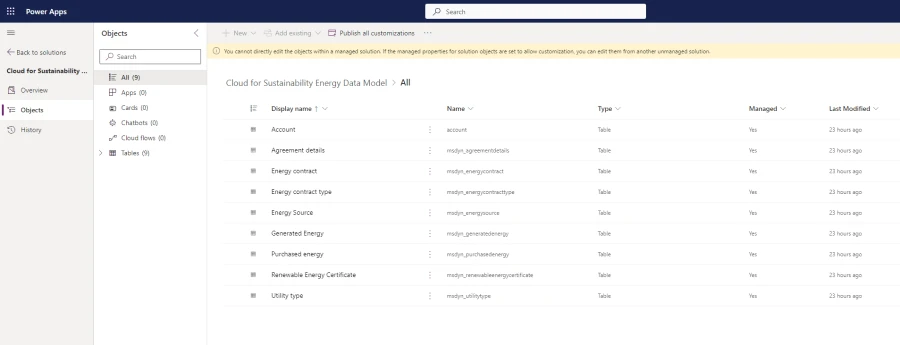
Improve carbon emissions reporting with activity to emissions traceability
In today’s sustainability-driven landscape, organizations turn to advanced solutions such as Sustainability Manager to monitor and mitigate their environmental footprint, with a primary focus on reducing greenhouse gas emissions and other pollutants. However, ensuring the accuracy and credibility of emissions data poses a significant challenge, given the intricacies of global supply chains, diverse data collection methods, and the potential for errors or discrepancies. This underscores the critical need to meticulously trace underlying activity data within Sustainability Manager to bolster transparency, accountability, and precision in tracking and reporting emissions data.
Activity to emissions traceability (preview) is a new feature in Sustainability Manager that enables you to trace and link underlying source activity data to emissions records, provided those calculations occur within the system. This capability addresses the pressing need for accurate, transparent, and reliable emissions reporting by providing a comprehensive traceability mechanism for all activity records tied to carbon emissions quantification. Not only does this feature empower you to gain deeper insights into your organization’s environmental impact, but it also streamlines the verification process for external auditors, regulators, and stakeholders. Activity to emissions traceability also enhances the credibility of sustainability reports and minimizes the risk of misrepresentation or greenwashing.
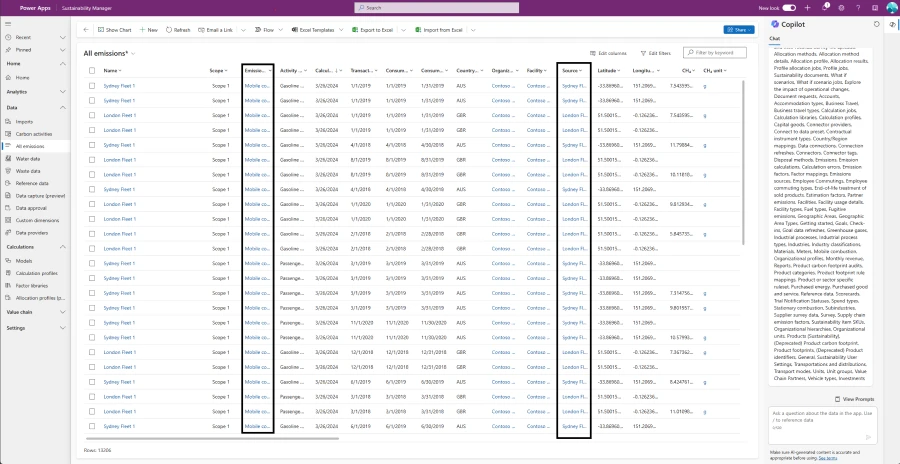
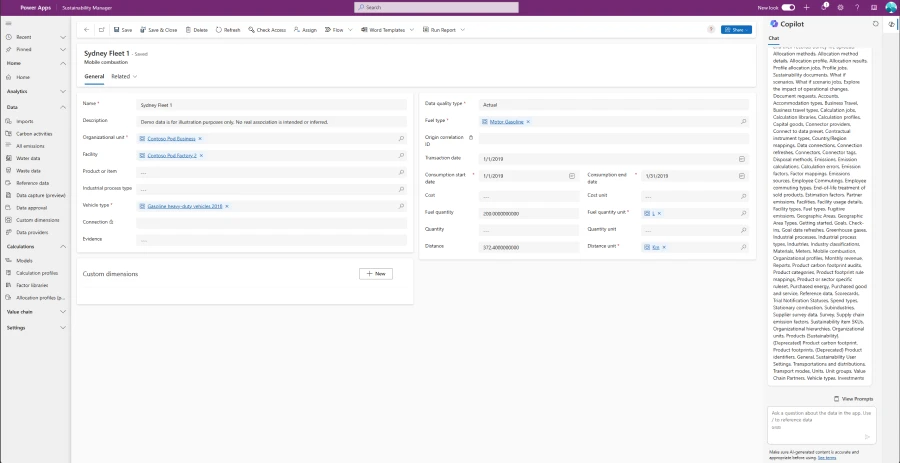
Create a Microsoft Power Query template to streamline and accelerate data import
Microsoft Power Query
The new Power Query guided experience is a comprehensive ingestion approach available within Sustainability Manager. It allows you to import data for multiple entities through multiple sources, all through a single import. Power Query templates in Sustainability Manager are available to help you with Power Query data imports. The templates automatically provide the right structure for all data attributes required to successfully import your data.
When designing a Power Query template, you can save and reapply a pattern for different activity details or sources. Power Query templates also support transfer of usage between users. An advanced user can set up a Power Query template for other sustainability practitioners to use on known input data shapes, as well as reuse a repeatable pattern to accelerate setup consistently.
Let’s say a user wants to create a template for mapping electricity, but the patterns need to be repeated from different sources. The source could be a parameter, or the “evidence” is different but everything else is the same. Previously, you would have to re-create the Power Query ingestion, mapping, and more. Using a Power Query template, you can create once and enter only the parameters that need to change for a new connection. The advanced user can create the template but can’t run it if they don’t know the connection details. The sustainability practitioner can use the template to create the connection.
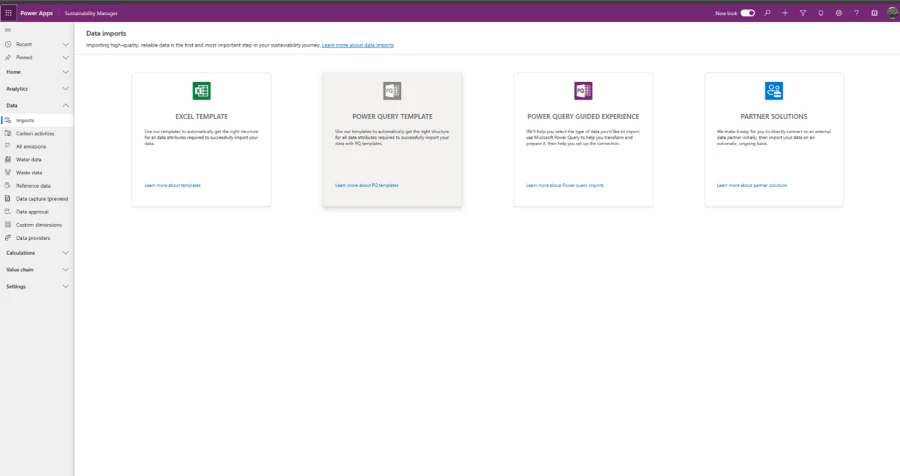
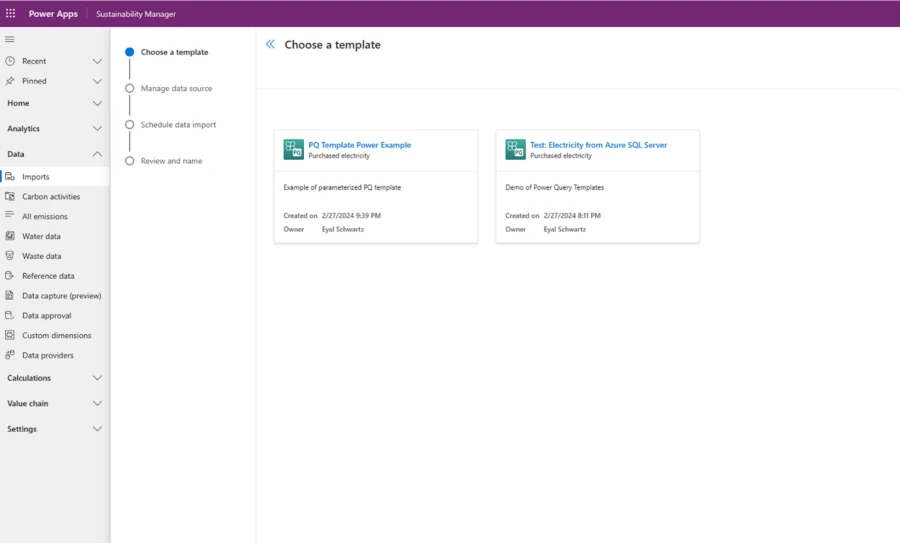
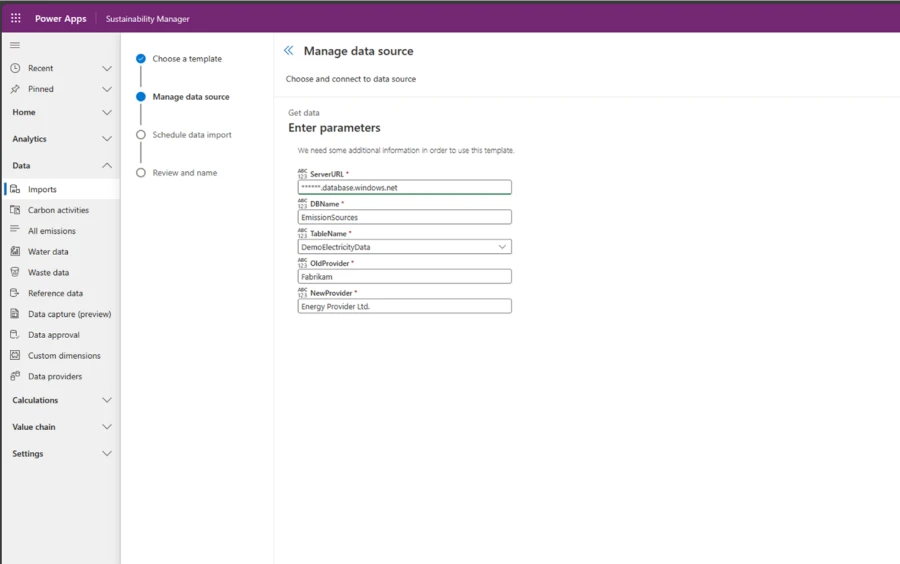
Further, with a new feature coming soon that will allow our growing list of partners to develop ingestion connections, you can package Power Query templates as a standalone package that can be distributed publicly and applied by customers.
New Sustainability Manager features coming soon
Starting April 2024, a new what-if analysis (preview) feature will allow you to forecast the impact of business practice changes on your overall emissions. Look for this and other changes coming to Sustainability Manager that will help you make informed decisions on how to reduce your organization’s carbon footprint and achieve your sustainability goals.
Learn more about sustainability solutions with Microsoft
- Bookmark Microsoft Industry Blogs: Sustainability for the latest updates, including new capabilities we’re introducing across Microsoft Cloud for Sustainability.
- Want to learn more about Microsoft Cloud for Sustainability? Sign up for news and updates and try it for free.
- Discover solutions with Microsoft Sustainability Manager.
- Learn about new data solutions and generative AI advancements in Microsoft Cloud for Sustainability.
- Learn how to improve your circularity data with Microsoft Sustainability Manager.
- Learn about the new Microsoft Cloud for Sustainability Community portal, a vibrant hub for learning, connecting, and contributing.
The post Use natural language and generative AI to create calculation models, streamline data collection, and improve reporting appeared first on Microsoft Industry Blogs.
Source: Microsoft Industry Blog
